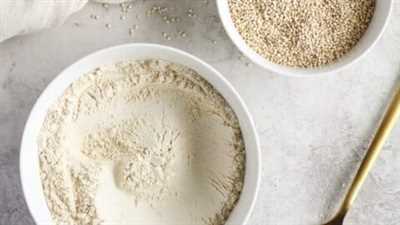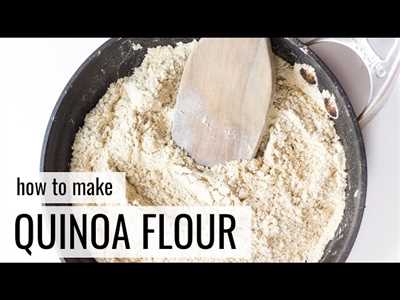
If you are looking to add a new ingredient to your baking recipes, quinoa flour is an excellent choice. Not only does it have a high protein content, but it also contains a good amount of fiber. Quinoa flour is easy to make at home, and it can be used in a variety of different recipes, from pastries to bread. In this article, we will show you how to make quinoa flour with a few simple steps.
To start, you should rinse your quinoa thoroughly to remove any bitter taste. Place the quinoa in a fine-mesh strainer and run it under cold water for a minute or two. This helps to remove the bitter coating that can sometimes be on the grains. Once you have rinsed the quinoa well, you are ready to blend it into flour.
There are a few different methods you can use to grind your quinoa into flour. One option is to use a high-speed blender. Simply add the rinsed quinoa to the blender and blend on high until the quinoa is ground into a fine powder. Another option is to use a coffee grinder. Make sure to choose a grinder that is clean and free from any coffee grounds. Add the quinoa to the grinder in small batches and grind until it becomes a fine flour.
If you want to give your quinoa flour a roasted flavor, you can toast the quinoa in a dry skillet before grinding it. To do this, heat a skillet over medium heat and add the rinsed quinoa. Stir the quinoa constantly for a few minutes until it becomes golden brown. Be careful not to burn the quinoa. Once it has cooled, you can grind it into flour just like the regular quinoa.
Once you have ground your quinoa into flour, it is important to store it properly to maintain its freshness. Quinoa flour should be stored in an airtight container in a cool, dark place. It will keep for several months if stored properly. When using the flour in recipes, make sure to follow the instructions carefully, as quinoa flour can behave differently than regular flour. It may require a little more liquid or a longer baking time.
Using quinoa flour in your recipes is a wonderful way to add a new flavor and color to your baked goods. It can also be a good substitute for those with gluten sensitivities. We hope this article has given you all the information you need on how to make quinoa flour at home. Give it a try and see how it enhances your cooking!
What does quinoa flour taste like
Quinoa flour has a unique taste that can be described as nutty and slightly earthy. It has a distinct flavor that sets it apart from other types of flour.
When you give quinoa flour a taste test, you might notice that it has a slightly bitter aftertaste. However, the bitterness is very mild and not overpowering. If you find the bitterness to be too strong, you can try rinsing the quinoa before grinding it into flour to help reduce the bitterness.
Another thing to keep in mind is that the freshness of the quinoa will greatly affect the taste of the flour. If you use fresh quinoa, the flour will have a brighter and more vibrant flavor. On the other hand, if you use quinoa that has been sitting for months, the flour might taste a little stale.
Quinoa flour is a good option for those who are looking for a gluten-free alternative to traditional flours. It is also high in protein, making it a nutritious choice. You can use quinoa flour in a variety of recipes, from pastries to breads and even pancakes.
When grinding quinoa to make flour, it is recommended to use a coffee grinder or a high-powered blender. These appliances will give the flour a fine texture and it’ll come out perfect for your baking needs.
The color of quinoa flour can vary depending on the type of quinoa used. White quinoa will give you a light-colored flour, while red or black quinoa will result in a darker flour. The difference in color does not affect the taste of the flour.
Overall, quinoa flour has a wonderful flavor that blends well with many different ingredients. It is a versatile ingredient that can enhance the taste of your dishes and provide a healthful source of nutrients.
How to Grind Quinoa Flour at Home

If you’re looking to make your own quinoa flour at home, it’s actually much easier than you might think. Not only does grinding quinoa flour yourself allow for much greater freshness and control over the grinding process, but it also lets you save money compared to buying pre-ground flour from the store.
To start, you’ll need a grinder that’s capable of grinding grains into flour. A high-speed blender or a dedicated flour mill are both good options for this. Make sure to clean your grinder well before using it, as any residue from previous ingredients could affect the taste of your flour.
Before grinding the quinoa, you’ll want to rinse it well to remove any bitter taste or residue. Place the quinoa in a fine mesh strainer and rinse it under cold water for a minute or two. This will help to remove any impurities and ensure a clean flavor for your flour.
Once your quinoa is rinsed and well-drained, you can pour it into the grinder. You’ll want to grind the quinoa in small batches, as grinding too much at once can cause an uneven grind. Aim for about 1 cup of quinoa at a time to ensure a consistent texture.
Turn on your grinder and let it run for a few minutes, or until the quinoa is ground into a fine flour. You may need to stop and scrape down the sides of the grinder from time to time to ensure that all of the quinoa gets ground evenly.
When the quinoa flour is ground to your desired fineness, it’s ready to use in your favorite recipes. Quinoa flour works well in a variety of dishes, including breads, pastries, and even as a thickener for sauces and soups. Its mild flavor and light color make it a versatile option in the kitchen.
It’s worth noting that freshly ground quinoa flour may have a slightly different texture and taste compared to store-bought flour. This is a good thing, as the freshness of the flour will give your recipes a wonderful flavor and texture. You may also notice that the flour has a slightly nutty aroma, which is another bonus.
One thing to keep in mind is that quinoa flour does contain a good amount of protein. This protein can sometimes make the flour a bit heavy, so if you prefer a lighter texture, you can blend the quinoa flour with another type of flour, such as all-purpose flour or almond flour.
In conclusion, making your own quinoa flour at home is easy and rewarding. It allows you to have control over the grinding process, ensuring freshness and quality in your flour. Plus, it’ll save you money in the long run. So, why not give grinding quinoa flour a try?
Instructions
If you’ve picked up some fresh quinoa from the store or if you have some quinoa at home that’s been sitting for a little while, you might want to make your own quinoa flour. Making quinoa flour at home is very easy and can give your recipes a wonderful freshness and flavor.
To start, you should rinse the quinoa to remove any bitterness. Rinse it well under cold water for about a minute. This helps to remove the saponin, a natural coating that can give quinoa a bitter taste.
After rinsing, you can grind the quinoa in a grinder or a high-speed blender. If you’re using a blender, blend the quinoa in small batches to ensure an even grind. Grind the quinoa until it becomes a fine powder.
Once the quinoa is ground, you now have your homemade quinoa flour! You can use it in a variety of recipes, such as bread, pastries, or even as a thickener for soups and sauces. The amount of quinoa flour you’ll need will vary depending on the recipe, so adjust accordingly.
Quinoa flour has a slightly nutty flavor and a light color, which can add a unique touch to your dishes. It’s also a great option for those who follow a gluten-free diet, as quinoa is naturally gluten-free. You can store your quinoa flour in an airtight container for several months.
In summary, making quinoa flour at home is an easy and essy process that can help you add a new flavor and texture to your cooking. Whether you’re looking to experiment with different recipes or you simply want to enjoy the nutritional benefits of quinoa, grinding your own quinoa flour is a great option.
Important: Before grinding your quinoa, make sure it’s completely dry. Moisture can cause the quinoa to clump together and the grinder might not work effectively. Additionally, if you’re using pre-roasted quinoa, be aware that it’ll have a slightly different taste and color compared to fresh quinoa. Lastly, if you’re using a blender, it’s recommended to blend the quinoa for a little longer to ensure a fine grind.
Sources
When it comes to making quinoa flour at home, there are several good sources to choose from. Here are a few options:
- Whole quinoa: This is the most common source for making quinoa flour. Simply grind the whole quinoa in a coffee grinder or a high-powered blender until it turns into a fine powder.
- Roasted quinoa: If you prefer a more nutty flavor, you can use roasted quinoa instead. Roasting the quinoa before grinding it will give the flour a unique taste.
- Pre-ground quinoa flour: If you don’t have the time or equipment to grind your own quinoa, you can always buy pre-ground quinoa flour from a store. This is a convenient option and works well in various recipes.
Regardless of which source you choose, there are a few things to keep in mind. First, make sure to rinse the quinoa thoroughly before grinding it. This helps remove any bitterness and ensures a clean taste. Additionally, be mindful of the amount of quinoa you use. Too much can give the flour a strong flavor, while too little may not provide enough protein and nutrients.
Quinoa flour is a wonderful alternative to traditional wheat flour, as it is gluten-free and packed with protein. Its light color and mild taste make it suitable for a variety of pastries and other baked goods. Whether you opt for store-bought or make your own at home, quinoa flour is a versatile and nutritious ingredient to have in your kitchen.
Lastly, it’s worth noting that homemade quinoa flour should be stored in an airtight container in a cool, dry place. This helps maintain its freshness and extends its shelf life. When stored properly, quinoa flour can last for several months.
There are many different blenders and grinders available on the market that can help you with making quinoa flour. From high-powered blenders to dedicated flour grinders, there are options to suit every home cook’s needs. If you’re serious about making your own quinoa flour, we recommend investing in a good quality grinder or blender. It’ll make the process much easier and give you a fine-textured flour.
We hope this information helps you in your quest to make quinoa flour at home!









